Case Study: Strategic HRM to Address Absenteeism at HealthReach
VerifiedAdded on 2023/04/06
|7
|1199
|156
Case Study
AI Summary
This case study addresses the rising absenteeism and turnover rates among nursing staff at HealthReach, a large private healthcare provider. The root cause is identified as a shift towards employing more casual nurses to cut costs, leading to decreased job satisfaction, morale, and patient care quality. The analysis emphasizes the importance of strategic human resource management (HRM) practices, particularly the commitment model, over the control model. Recommendations include improving work environment, offering incentives, implementing employee involvement programs, and providing ongoing training. The case advocates for structural empowerment of nurses through professional advancement, better relationships with leadership, and increased autonomy to enhance job satisfaction, reduce burnout, and improve patient outcomes. The study concludes that treating the workforce as an asset and implementing recommended HR practices can reverse the negative trends and build a stronger, more effective organization. Desklib provides access to similar case studies and resources for students.
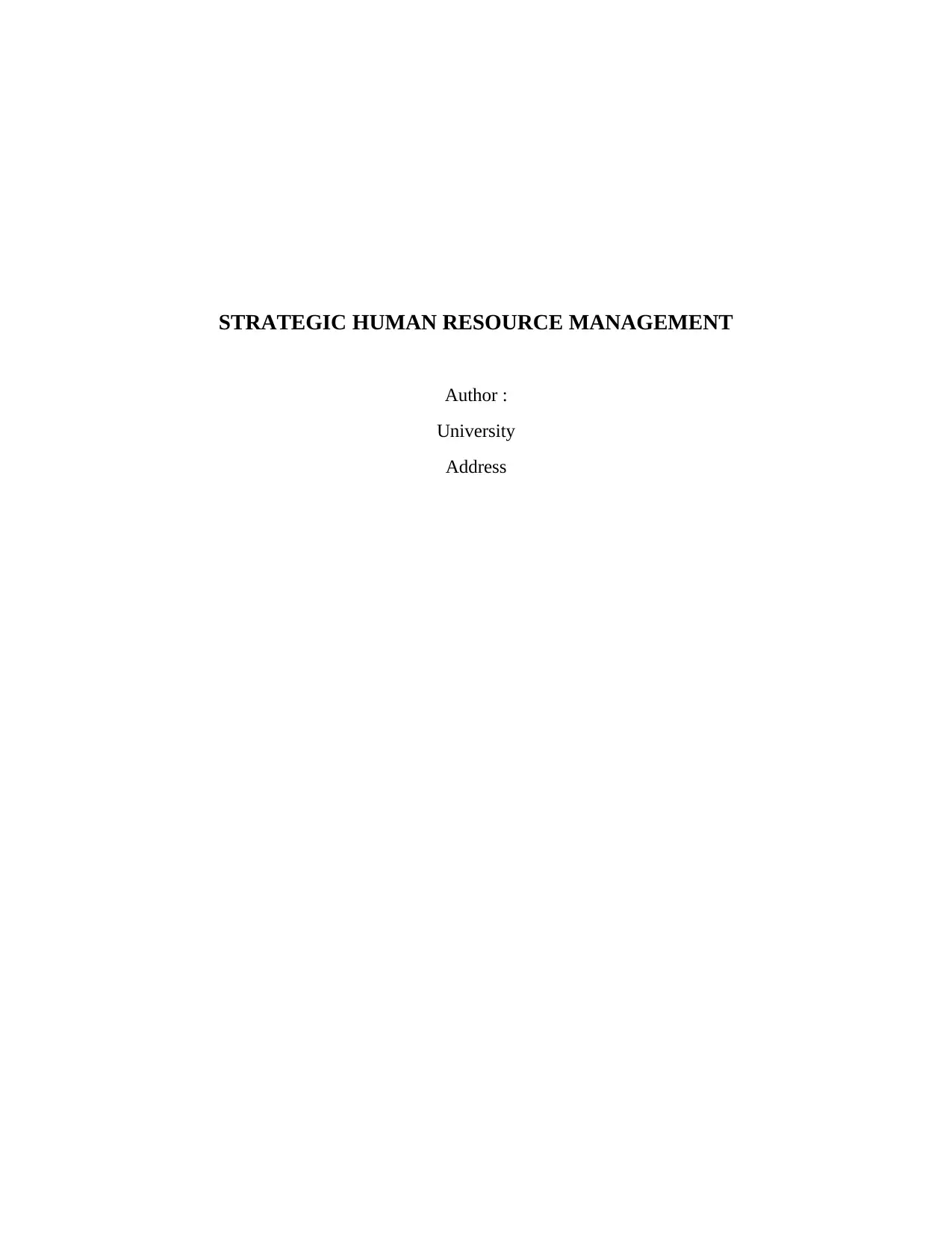
STRATEGIC HUMAN RESOURCE MANAGEMENT
Author :
University
Address
Author :
University
Address
Paraphrase This Document
Need a fresh take? Get an instant paraphrase of this document with our AI Paraphraser
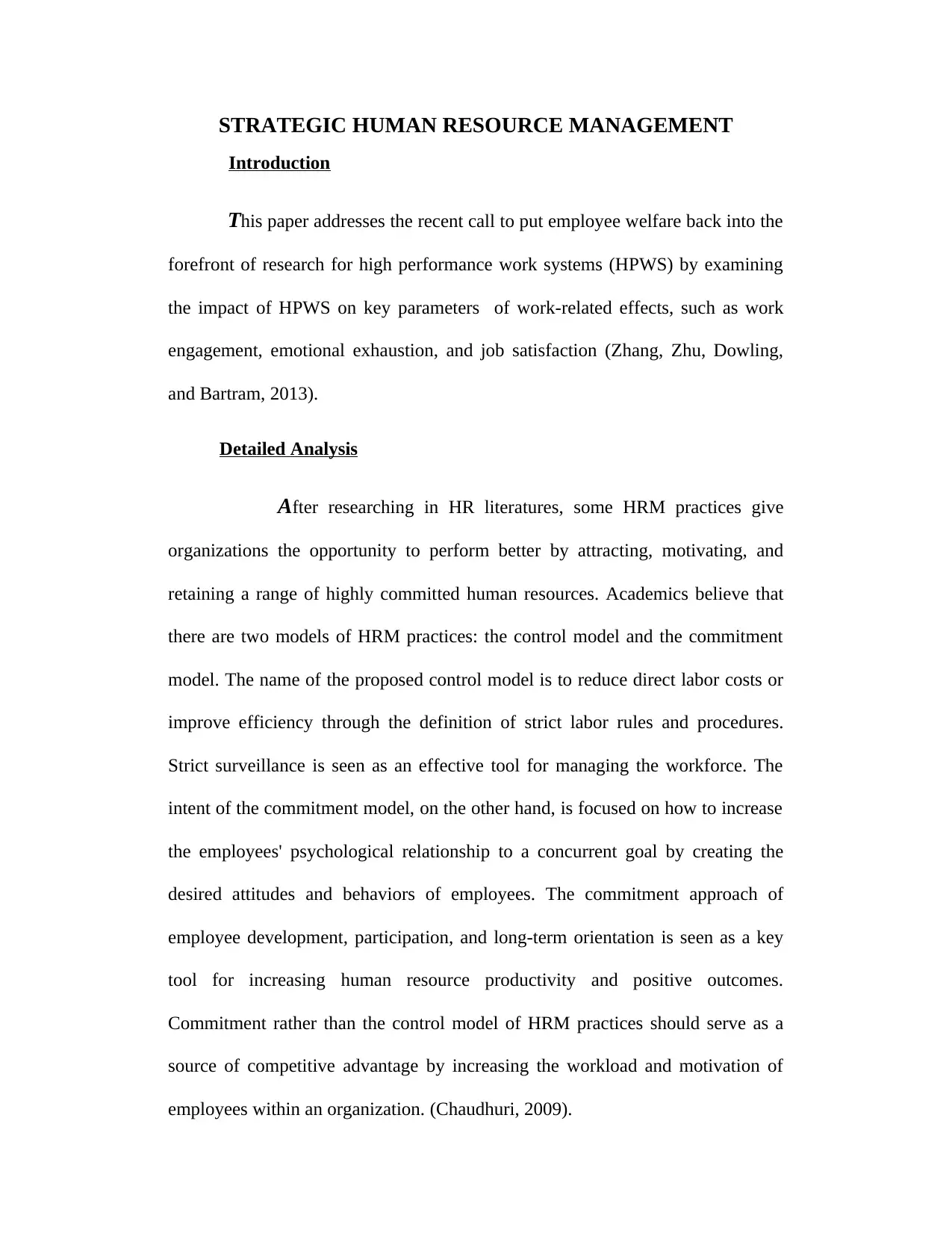
STRATEGIC HUMAN RESOURCE MANAGEMENT
Introduction
This paper addresses the recent call to put employee welfare back into the
forefront of research for high performance work systems (HPWS) by examining
the impact of HPWS on key parameters of work-related effects, such as work
engagement, emotional exhaustion, and job satisfaction (Zhang, Zhu, Dowling,
and Bartram, 2013).
Detailed Analysis
After researching in HR literatures, some HRM practices give
organizations the opportunity to perform better by attracting, motivating, and
retaining a range of highly committed human resources. Academics believe that
there are two models of HRM practices: the control model and the commitment
model. The name of the proposed control model is to reduce direct labor costs or
improve efficiency through the definition of strict labor rules and procedures.
Strict surveillance is seen as an effective tool for managing the workforce. The
intent of the commitment model, on the other hand, is focused on how to increase
the employees' psychological relationship to a concurrent goal by creating the
desired attitudes and behaviors of employees. The commitment approach of
employee development, participation, and long-term orientation is seen as a key
tool for increasing human resource productivity and positive outcomes.
Commitment rather than the control model of HRM practices should serve as a
source of competitive advantage by increasing the workload and motivation of
employees within an organization. (Chaudhuri, 2009).
Introduction
This paper addresses the recent call to put employee welfare back into the
forefront of research for high performance work systems (HPWS) by examining
the impact of HPWS on key parameters of work-related effects, such as work
engagement, emotional exhaustion, and job satisfaction (Zhang, Zhu, Dowling,
and Bartram, 2013).
Detailed Analysis
After researching in HR literatures, some HRM practices give
organizations the opportunity to perform better by attracting, motivating, and
retaining a range of highly committed human resources. Academics believe that
there are two models of HRM practices: the control model and the commitment
model. The name of the proposed control model is to reduce direct labor costs or
improve efficiency through the definition of strict labor rules and procedures.
Strict surveillance is seen as an effective tool for managing the workforce. The
intent of the commitment model, on the other hand, is focused on how to increase
the employees' psychological relationship to a concurrent goal by creating the
desired attitudes and behaviors of employees. The commitment approach of
employee development, participation, and long-term orientation is seen as a key
tool for increasing human resource productivity and positive outcomes.
Commitment rather than the control model of HRM practices should serve as a
source of competitive advantage by increasing the workload and motivation of
employees within an organization. (Chaudhuri, 2009).
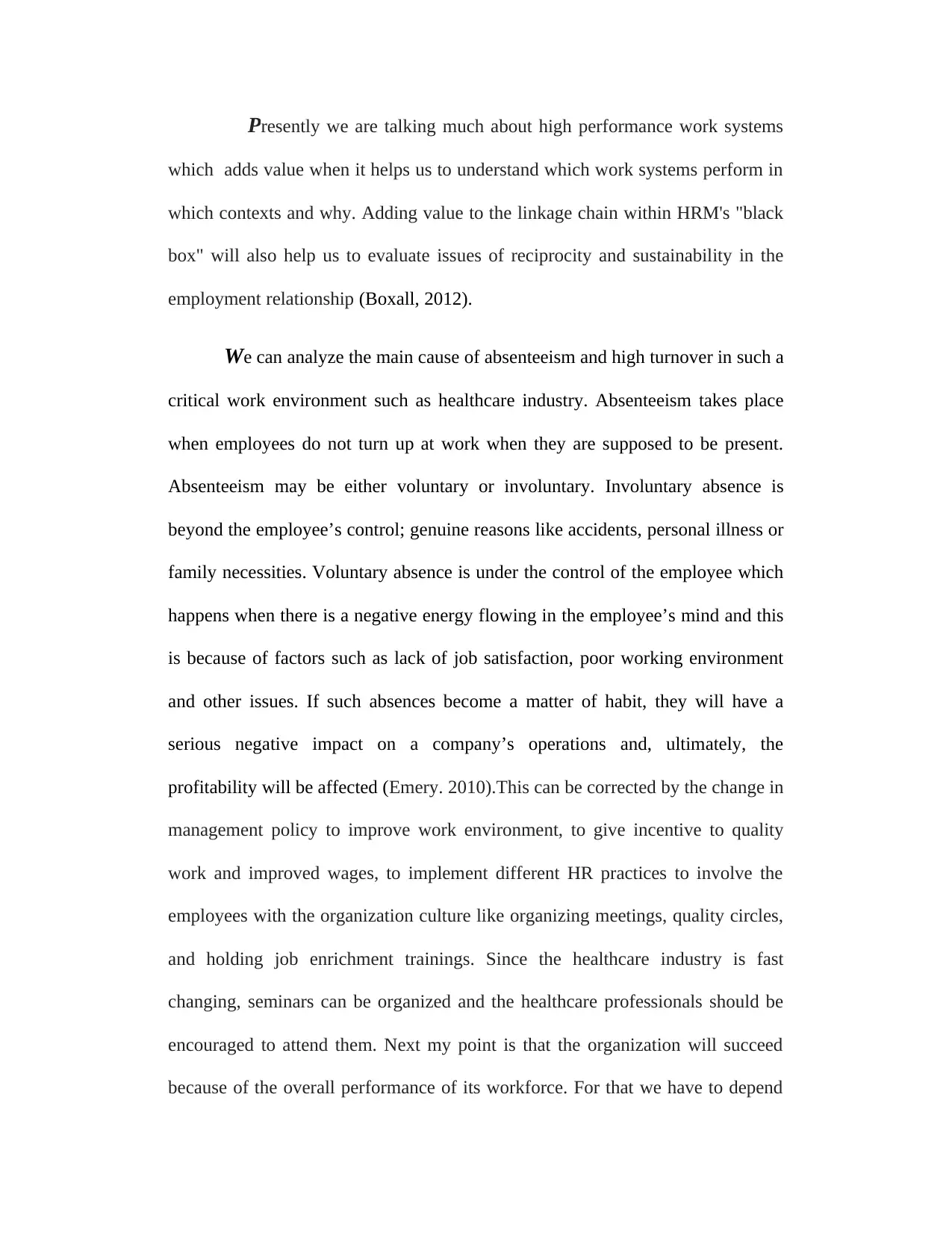
Presently we are talking much about high performance work systems
which adds value when it helps us to understand which work systems perform in
which contexts and why. Adding value to the linkage chain within HRM's "black
box" will also help us to evaluate issues of reciprocity and sustainability in the
employment relationship (Boxall, 2012).
We can analyze the main cause of absenteeism and high turnover in such a
critical work environment such as healthcare industry. Absenteeism takes place
when employees do not turn up at work when they are supposed to be present.
Absenteeism may be either voluntary or involuntary. Involuntary absence is
beyond the employee’s control; genuine reasons like accidents, personal illness or
family necessities. Voluntary absence is under the control of the employee which
happens when there is a negative energy flowing in the employee’s mind and this
is because of factors such as lack of job satisfaction, poor working environment
and other issues. If such absences become a matter of habit, they will have a
serious negative impact on a company’s operations and, ultimately, the
profitability will be affected (Emery. 2010).This can be corrected by the change in
management policy to improve work environment, to give incentive to quality
work and improved wages, to implement different HR practices to involve the
employees with the organization culture like organizing meetings, quality circles,
and holding job enrichment trainings. Since the healthcare industry is fast
changing, seminars can be organized and the healthcare professionals should be
encouraged to attend them. Next my point is that the organization will succeed
because of the overall performance of its workforce. For that we have to depend
which adds value when it helps us to understand which work systems perform in
which contexts and why. Adding value to the linkage chain within HRM's "black
box" will also help us to evaluate issues of reciprocity and sustainability in the
employment relationship (Boxall, 2012).
We can analyze the main cause of absenteeism and high turnover in such a
critical work environment such as healthcare industry. Absenteeism takes place
when employees do not turn up at work when they are supposed to be present.
Absenteeism may be either voluntary or involuntary. Involuntary absence is
beyond the employee’s control; genuine reasons like accidents, personal illness or
family necessities. Voluntary absence is under the control of the employee which
happens when there is a negative energy flowing in the employee’s mind and this
is because of factors such as lack of job satisfaction, poor working environment
and other issues. If such absences become a matter of habit, they will have a
serious negative impact on a company’s operations and, ultimately, the
profitability will be affected (Emery. 2010).This can be corrected by the change in
management policy to improve work environment, to give incentive to quality
work and improved wages, to implement different HR practices to involve the
employees with the organization culture like organizing meetings, quality circles,
and holding job enrichment trainings. Since the healthcare industry is fast
changing, seminars can be organized and the healthcare professionals should be
encouraged to attend them. Next my point is that the organization will succeed
because of the overall performance of its workforce. For that we have to depend
⊘ This is a preview!⊘
Do you want full access?
Subscribe today to unlock all pages.

Trusted by 1+ million students worldwide
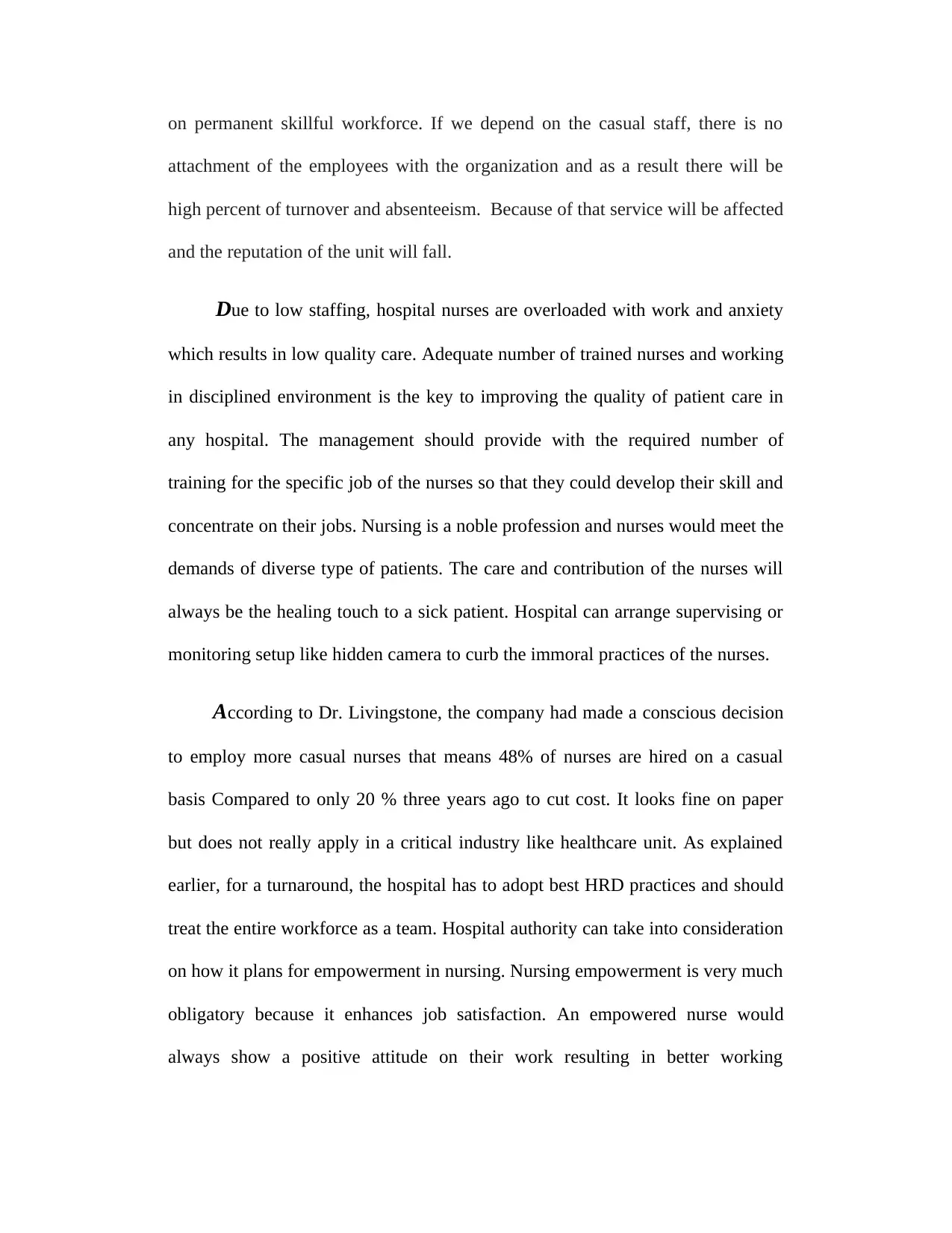
on permanent skillful workforce. If we depend on the casual staff, there is no
attachment of the employees with the organization and as a result there will be
high percent of turnover and absenteeism. Because of that service will be affected
and the reputation of the unit will fall.
Due to low staffing, hospital nurses are overloaded with work and anxiety
which results in low quality care. Adequate number of trained nurses and working
in disciplined environment is the key to improving the quality of patient care in
any hospital. The management should provide with the required number of
training for the specific job of the nurses so that they could develop their skill and
concentrate on their jobs. Nursing is a noble profession and nurses would meet the
demands of diverse type of patients. The care and contribution of the nurses will
always be the healing touch to a sick patient. Hospital can arrange supervising or
monitoring setup like hidden camera to curb the immoral practices of the nurses.
According to Dr. Livingstone, the company had made a conscious decision
to employ more casual nurses that means 48% of nurses are hired on a casual
basis Compared to only 20 % three years ago to cut cost. It looks fine on paper
but does not really apply in a critical industry like healthcare unit. As explained
earlier, for a turnaround, the hospital has to adopt best HRD practices and should
treat the entire workforce as a team. Hospital authority can take into consideration
on how it plans for empowerment in nursing. Nursing empowerment is very much
obligatory because it enhances job satisfaction. An empowered nurse would
always show a positive attitude on their work resulting in better working
attachment of the employees with the organization and as a result there will be
high percent of turnover and absenteeism. Because of that service will be affected
and the reputation of the unit will fall.
Due to low staffing, hospital nurses are overloaded with work and anxiety
which results in low quality care. Adequate number of trained nurses and working
in disciplined environment is the key to improving the quality of patient care in
any hospital. The management should provide with the required number of
training for the specific job of the nurses so that they could develop their skill and
concentrate on their jobs. Nursing is a noble profession and nurses would meet the
demands of diverse type of patients. The care and contribution of the nurses will
always be the healing touch to a sick patient. Hospital can arrange supervising or
monitoring setup like hidden camera to curb the immoral practices of the nurses.
According to Dr. Livingstone, the company had made a conscious decision
to employ more casual nurses that means 48% of nurses are hired on a casual
basis Compared to only 20 % three years ago to cut cost. It looks fine on paper
but does not really apply in a critical industry like healthcare unit. As explained
earlier, for a turnaround, the hospital has to adopt best HRD practices and should
treat the entire workforce as a team. Hospital authority can take into consideration
on how it plans for empowerment in nursing. Nursing empowerment is very much
obligatory because it enhances job satisfaction. An empowered nurse would
always show a positive attitude on their work resulting in better working
Paraphrase This Document
Need a fresh take? Get an instant paraphrase of this document with our AI Paraphraser
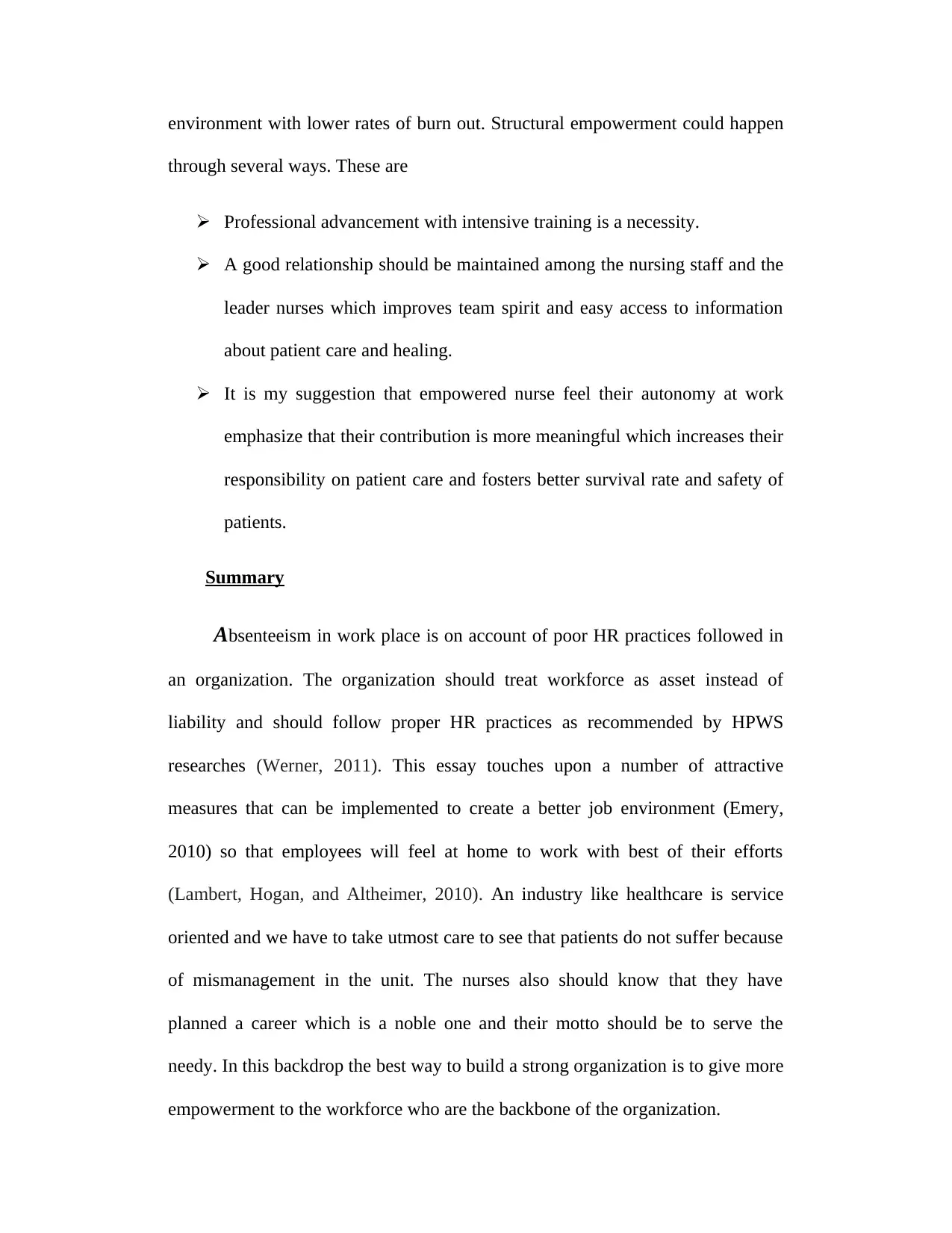
environment with lower rates of burn out. Structural empowerment could happen
through several ways. These are
Professional advancement with intensive training is a necessity.
A good relationship should be maintained among the nursing staff and the
leader nurses which improves team spirit and easy access to information
about patient care and healing.
It is my suggestion that empowered nurse feel their autonomy at work
emphasize that their contribution is more meaningful which increases their
responsibility on patient care and fosters better survival rate and safety of
patients.
Summary
Absenteeism in work place is on account of poor HR practices followed in
an organization. The organization should treat workforce as asset instead of
liability and should follow proper HR practices as recommended by HPWS
researches (Werner, 2011). This essay touches upon a number of attractive
measures that can be implemented to create a better job environment (Emery,
2010) so that employees will feel at home to work with best of their efforts
(Lambert, Hogan, and Altheimer, 2010). An industry like healthcare is service
oriented and we have to take utmost care to see that patients do not suffer because
of mismanagement in the unit. The nurses also should know that they have
planned a career which is a noble one and their motto should be to serve the
needy. In this backdrop the best way to build a strong organization is to give more
empowerment to the workforce who are the backbone of the organization.
through several ways. These are
Professional advancement with intensive training is a necessity.
A good relationship should be maintained among the nursing staff and the
leader nurses which improves team spirit and easy access to information
about patient care and healing.
It is my suggestion that empowered nurse feel their autonomy at work
emphasize that their contribution is more meaningful which increases their
responsibility on patient care and fosters better survival rate and safety of
patients.
Summary
Absenteeism in work place is on account of poor HR practices followed in
an organization. The organization should treat workforce as asset instead of
liability and should follow proper HR practices as recommended by HPWS
researches (Werner, 2011). This essay touches upon a number of attractive
measures that can be implemented to create a better job environment (Emery,
2010) so that employees will feel at home to work with best of their efforts
(Lambert, Hogan, and Altheimer, 2010). An industry like healthcare is service
oriented and we have to take utmost care to see that patients do not suffer because
of mismanagement in the unit. The nurses also should know that they have
planned a career which is a noble one and their motto should be to serve the
needy. In this backdrop the best way to build a strong organization is to give more
empowerment to the workforce who are the backbone of the organization.
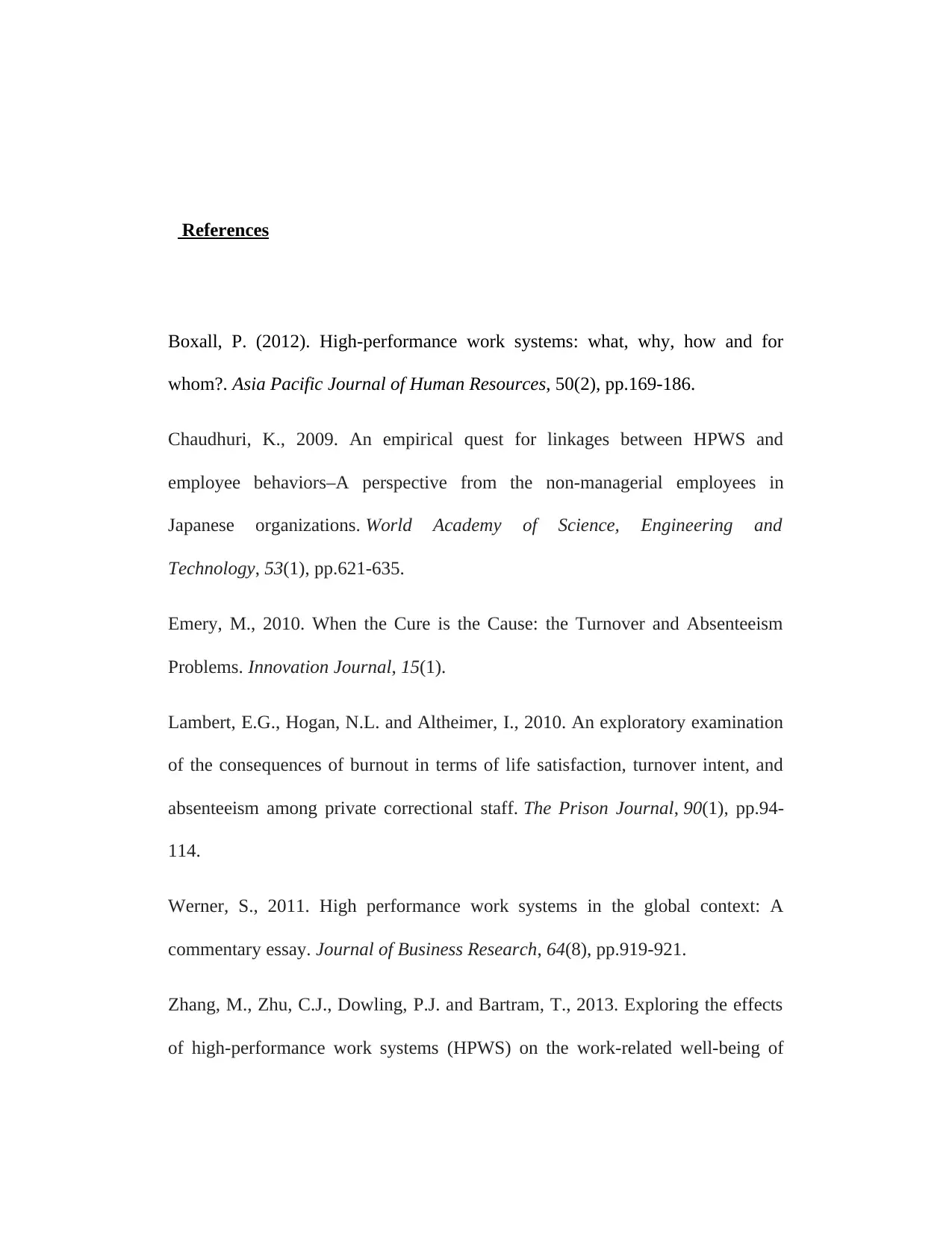
References
Boxall, P. (2012). High-performance work systems: what, why, how and for
whom?. Asia Pacific Journal of Human Resources, 50(2), pp.169-186.
Chaudhuri, K., 2009. An empirical quest for linkages between HPWS and
employee behaviors–A perspective from the non-managerial employees in
Japanese organizations. World Academy of Science, Engineering and
Technology, 53(1), pp.621-635.
Emery, M., 2010. When the Cure is the Cause: the Turnover and Absenteeism
Problems. Innovation Journal, 15(1).
Lambert, E.G., Hogan, N.L. and Altheimer, I., 2010. An exploratory examination
of the consequences of burnout in terms of life satisfaction, turnover intent, and
absenteeism among private correctional staff. The Prison Journal, 90(1), pp.94-
114.
Werner, S., 2011. High performance work systems in the global context: A
commentary essay. Journal of Business Research, 64(8), pp.919-921.
Zhang, M., Zhu, C.J., Dowling, P.J. and Bartram, T., 2013. Exploring the effects
of high-performance work systems (HPWS) on the work-related well-being of
Boxall, P. (2012). High-performance work systems: what, why, how and for
whom?. Asia Pacific Journal of Human Resources, 50(2), pp.169-186.
Chaudhuri, K., 2009. An empirical quest for linkages between HPWS and
employee behaviors–A perspective from the non-managerial employees in
Japanese organizations. World Academy of Science, Engineering and
Technology, 53(1), pp.621-635.
Emery, M., 2010. When the Cure is the Cause: the Turnover and Absenteeism
Problems. Innovation Journal, 15(1).
Lambert, E.G., Hogan, N.L. and Altheimer, I., 2010. An exploratory examination
of the consequences of burnout in terms of life satisfaction, turnover intent, and
absenteeism among private correctional staff. The Prison Journal, 90(1), pp.94-
114.
Werner, S., 2011. High performance work systems in the global context: A
commentary essay. Journal of Business Research, 64(8), pp.919-921.
Zhang, M., Zhu, C.J., Dowling, P.J. and Bartram, T., 2013. Exploring the effects
of high-performance work systems (HPWS) on the work-related well-being of
⊘ This is a preview!⊘
Do you want full access?
Subscribe today to unlock all pages.

Trusted by 1+ million students worldwide
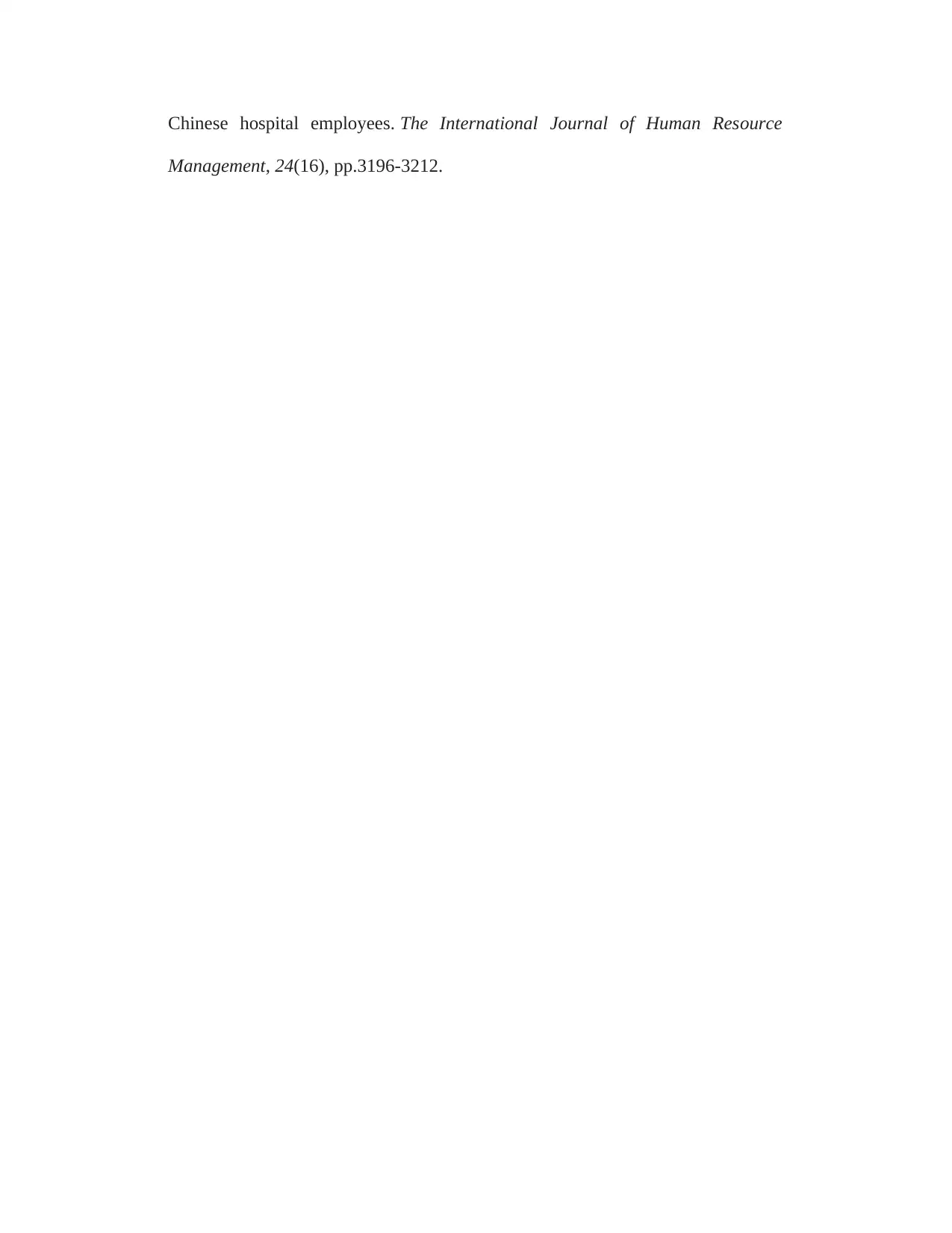
Chinese hospital employees. The International Journal of Human Resource
Management, 24(16), pp.3196-3212.
Management, 24(16), pp.3196-3212.
1 out of 7
Related Documents
Your All-in-One AI-Powered Toolkit for Academic Success.
+13062052269
info@desklib.com
Available 24*7 on WhatsApp / Email
![[object Object]](/_next/static/media/star-bottom.7253800d.svg)
Unlock your academic potential
Copyright © 2020–2025 A2Z Services. All Rights Reserved. Developed and managed by ZUCOL.



